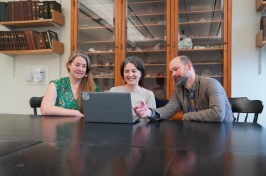
Serita Frey (left) and her Ph.D. student Sarah Andrews found that the hands-on, active-learning approach of Frey's Studio Soils course led to better student outcomes than a traditional lecture class.
In 2010, about a decade into teaching the large Introduction to Soils course, UNH soil scientist Serita Frey steered her class into uncharted territory. With inspiration from the physics department and a grant from the U.S. Department of Agriculture, Frey abandoned the traditional three-lectures-and-a-lab format and took soils into the studio.
This spring, five years after the debut of the Studio Soils course, research published by Frey’s doctoral student Sarah Andrews shows what Frey and others have suspected: The hands-on, active-learning approach of Studio Soils leads to better student outcomes than the traditional lecture course did.
“The studio students generally performed better on exams, research reports, and their final grades. But the biggest findings were that we saw a reduced fail rate,” says Andrews, whose article, co-authored by Frey, was published in the journal Natural Sciences Education. Just four percent of students in the studio-style course received a grade lower than a C, compared to 17 percent in the traditional course.
Andrews also found that lower-performing students, those who entered the course with lower grade-point averages, made the greatest gains in the studio course compared to the traditional format. “Studio Soils was bringing up the bottom end of the class, which is always a concern,” says Frey.
The premise behind so-called studio science courses, which have been more widely embraced by the physical sciences (including UNH’s physics department) than the natural and biological sciences, is “to minimize lectures and have hands-on activities,” says Frey, a professor of natural resources and the environment. In two two-hour sessions each week, Studio Soils integrates brief lectures with small-group discussions, problem-solving, lab work and field work.
Frey and Andrews, who was a teaching assistant in the traditional lecture/lab class for one year and in Studio Soils for two, detail other reasons they suspect the studio format gives its 72 students an edge in understanding the physical, chemical and biological properties of dirt.
The studio class gives students more face time with the instructors, engages them more deeply in their own learning, teaches material in a variety of ways and minimizes absenteeism. “It's fine to have a lecture when 10 students don't show up, but when group members are missing from activities in a studio class, you really notice it,” says Frey.
Frey reorganized some of the course material to take advantage of the studio format; she thinks it’s presented in a more powerful way now. Where she once taught soil taxonomy — how soils are named — in one week of “very dry material and rote memorization,” she now weaves it throughout the Earth systems-approach to soils. And instead of students waiting until a Friday lab to practice what they learned in a Monday lecture, for instance, learning and application are nearly seamless.
Andrews’s passion for pedagogy arose from a fellowship with TESSE (Transforming Earth System Science Education), a UNH professional development program for middle and high school science teachers.
Crediting the flexibility of the Natural Resources and Earth Systems Science Ph.D. program, she integrated her teaching methods research with her primary scientific work on how plant community composition influences methane emissions in wetlands into her dissertation, called “Relationships Between Structure and Function: System Structure Matters Whether You Are In a Wetland or a College Classroom.”
“It's a loose connection, to be sure,” she laughs, but one that worked. She’s been teaching at Great Bay Community College since she finished her doctoral work in the fall of 2014; she’ll collect her diploma at commencement on Saturday.
Frey is hopeful that Andrews’ research, along with the positive feedback from Studio Soils and Studio Physics, will encourage more UNH faculty to embrace a studio format. They have allies in the physics department, which launched an integrated physics and calculus class in 1998 and a physics-only studio about a decade later.
“Studio is effective because it gives all students an opportunity to struggle with ideas and make them their own. It makes clear that learning is far more than receiving and memorizing information,” says associate professor of physics Dawn Meredith, who launched Studio Physics at UNH and currently teaches the course.
Frey adds that it hones the critical thinking skills students need to succeed in college, graduate school and the workplace.
“At the end of the day, I don't care so much if they remember the specifics of soil taxonomy,” she says. “For me, it's that they’ve learned how to learn, that they picked up some skills of engagement and discussion and critical thinking that they will take with them beyond this class.”
-
Written By:
Beth Potier | UNH Marketing | beth.potier@unh.edu | 2-1566





















































